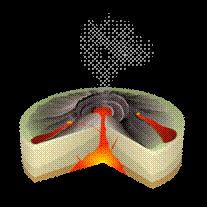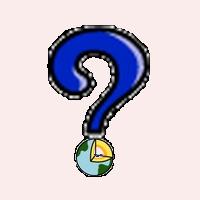Olympiaberg München
DEU: Für gewöhnlich entstehen Berge durch plattentektonische oder vulkanische Prozesse. Als Beispiele können hier für ein tektonisches Deckengebirge die Alpen genannt werden. Starker seitlicher Schub ohne eine Ausweichmöglichkeit schuf diese Formation.
ENG: Mountainusually are formed by plate tectonics or volcanic processes. As an example the Alps can be mentioned here for a tectonic blanket. Strong lateral thrust has created the Alps formation.
 Bild: Tektonische Überschiebung Alpen (Quelle: Woudloper)
Bild: Tektonische Überschiebung Alpen (Quelle: Woudloper)
DEU: Vulkanisches Gebirge entsteht hingegen durch das Aneinanderwachsen mehrerer Eruptionsherde oder aus einer einzelnen harten Ergussmasse, wie sie z.B. am Vogelsberg in Hessen zu sehen ist.
ENG: Volcanic mountains are formed by multiple eruptions like the Mountain Vogelsberg in Hesse.
 Bild: Vulkanisches Gebirge Vogelsberg (Quelle: Sémhur)
Bild: Vulkanisches Gebirge Vogelsberg (Quelle: Sémhur)
DEU: Neben dieser traditionellen Entstehung von Gebirgen, existieren in Deutschland auch Formationen, die anders erschaffen wurden. Einen besonderen Fall stellt exemplarisch der Olympiaberg dar.
ENG: In addition to these traditional formation of mountains, in Germany there are also formations that have been created differently. A special case is the so-called Olympic Mountain Munich.
Olympic Mountain Munich
DEU: Als im Jahre 1966 das Internationale Olympische Komitee die Spiele an München vergab, wurden die Pläne für die städtebauliche Neuordnung des zukünftigen Olympiaparks konkret. Nachdem der Flugbetrieb 1939 vom bis dahin als Flugplatz genutzten Oberwiesenfeld auf den damals neu eröffneten Flughafen München-Riem verlegt wurde, lag das Gebiet brach. Es beheimatete nach dem II. Weltkrieg nur einen der drei großen Berge in München.
ENG: In 1966, the International Olympic Committee awarded the Olympic Games to the city of Munich and so, plans for the reorganization of the urban future of the Olympic Park (formaly known as the Oberwiesenfeld) became concrete. During WW II the Oberwiesenfeld was used as an airfield - after the end of the war, the airport was moved to Munich-Riem, the Oberwiesenfeld lay fallow. There was only one of three munich mountains.
DEU: Den Berg kann man heute noch besuchen – üppige Begrünung und landschaftliche Gestaltung zogen ein, als das Gelände für die Spiele 1972 hergerichtet wurde.
ENG: The mountain still can be visited - a lot of greenery and landscaping was done for the games 1972.
DEU: Rund um den Berg wurde in der Zeit von 1968 bis 1972 ein Park errichtet. Die Gesamtkosten betrugen stattliche 1,35 Milliarden DM.!!!
ENG: The park rounding the mountain was built between 1968 and 1972. Total cost: €700.000.000 = $ 1.0 billion !!!
DEU: Mit 160 Hektar (ca. 200 Fußballfelder) gehört der Olympiapark zu den größten Grünanlagen Münchens. Sieben Millionen Kubikmeter Erde wurden dafür versetzt und mehr als 3.000 Bäume gepflanzt. Der Olympiaberg ist eine der höchsten Erhebungen Münchens.
ENG: Counting160 hectares (about 200 football fields) the Olympic Park is one of the largest parks in Munich. Seven million cubic meters of earth were moved to build it and more than 3,000 trees had been planted. The Olympic mountain is one of the highest elevations of Munich.
DEU: Neben dem Olympiaberg – der gern besuchten Erhebung bei Rock- und Popkonzerten, Feuerwerken und anderen Events, findet man an seinem nördlichen Ausläufer, den Olympiasee. Sein Wasservolumen beträgt 110.000 m³ (entspricht ca. 1 Million Badewannen). Der See wird auch durch das Wasser gespeist, das bei Regen von den Dächern durch Rohrleitungen gesammelt wird. Zudem trägt der Olympiasee maßgeblich dazu bei, dass sich der gesamte Olympiapark zu einer wichtigen Zwischenstation für Zugvögel auf ihren Wanderungen entwickelt hat.
ENG:Nearby the Olympic mountain - hot spot for visiting rock and pop concerts, fireworks and other events, the Olympic Lake is located on the northern foothills. Its water volume is 110,000 m³ (equivalent to approximately 1 million bathtubs). The lake is also fed by the water that is collected by rain-pipes from the roofs of the surrounding buildings in the park. In addition, the Olympic lake contributes significantly as a stopover for migratory birds on their migrations.
DEU: Um den Earthcache zu loggen, möchte ich Euch bitten, folgende Fragen zu beantworten und Eure die Messungen mit einem Bild unter Beweis zu stellen:
ENG: To log the Earthcache please answer the following questions and take a photo of yourself proofing Your tasks:
Frage 1 / Question 1:
DEU: Geologisch betrachtet ist der Olympiaberg?
ENG: What sort of geological formation is the Olympic mountain?
Mögliche Antworten / Answers:
q Schuttberg / Pile of rubble (0)
q Plateauberg / Sedimentary rock (1)
q Inselberg / Monadnock (2)
 DEU: Erste Aufgabe: Besuche die Informationstafel bei N48° 10.160 E11° 33.150. Hier erhältst Du einen eindeutigen Hinweis auf die geologische Herkunft des Berges.
DEU: Erste Aufgabe: Besuche die Informationstafel bei N48° 10.160 E11° 33.150. Hier erhältst Du einen eindeutigen Hinweis auf die geologische Herkunft des Berges.
ENG: Fist task: Gather informations on the mountain formation at N48° 10.160 E11° 33.150. You will find a clearly hint there.
Frage 2 / Question 2:
DEU: Wie hoch ragt der Berg über die Seenlandschaft des Parks?
ENG: What is the height of the mountain ?
Mögliche Antworten / Answers:
q 30m – 44m (3)
q 50m – 66m (4)
q 70m – 88m (5)
 DEU: Zweite Aufgabe: Lese Deinen Höhenmesser am höchsten Punkt des Berges ab. Vergleiche den Wert mit dem, den Du am Fuß des Berges ermittelst. Foto bitte nicht vergessen.
DEU: Zweite Aufgabe: Lese Deinen Höhenmesser am höchsten Punkt des Berges ab. Vergleiche den Wert mit dem, den Du am Fuß des Berges ermittelst. Foto bitte nicht vergessen.
ENG: Second task: Have a look at your altimeter at the highest spot of the mountain. Compare the data with altimeter value near the base of the mountain. Take a picture.
Frage 3 / Question 3:
DEU: Am Fuß des Berges liegt der Olympiasee. Wie tief ist der See?
ENG: On the foot of the mountain, you will find a lake. How deep is the lake?
Mögliche Antworten / Answers:
q 0.5m – 1.5m (6)
q 1.5m – 2m (7)
q 2m – 6m (8)
 DEU: Dritte Aufgabe: Ermittle z.B. von einer Brücke aus, die Tiefe des Sees mit einem Senklot. Foto bitte nicht vergessen.
DEU: Dritte Aufgabe: Ermittle z.B. von einer Brücke aus, die Tiefe des Sees mit einem Senklot. Foto bitte nicht vergessen.
ENG: Third task: Determine the depth of the lake by using a plumb-line. Take a picture.
DEU: Zu guter Letzt darf ich Euch darum bitten, die Fotos nach der Logfreigabe in den „Found it“-Log hochzuladen.
ENG: Last but not least - please attach the pictures to your "fount-it" at Geocaching.com.
DEU: Um den Log zu machen, bitte eine eMail an: z.B.: "Earthcache???(at)arcor.de" senden - wenn was nicht stimmt, melde ich mich.
ENG: To log Your "found-it" please send an eMail at "Earthcache???(at)arcor.de" I will reply if your answers need correction.
Beispiel / Example: Antwoten / Answers: "Inselberg/77m-88m/2m-6m" ---> Earthcache258(at)arcor.de
 Happy Hunting
Happy Hunting  wünscht Euch der googler25
wünscht Euch der googler25
 googler25-free-checker
googler25-free-checker 